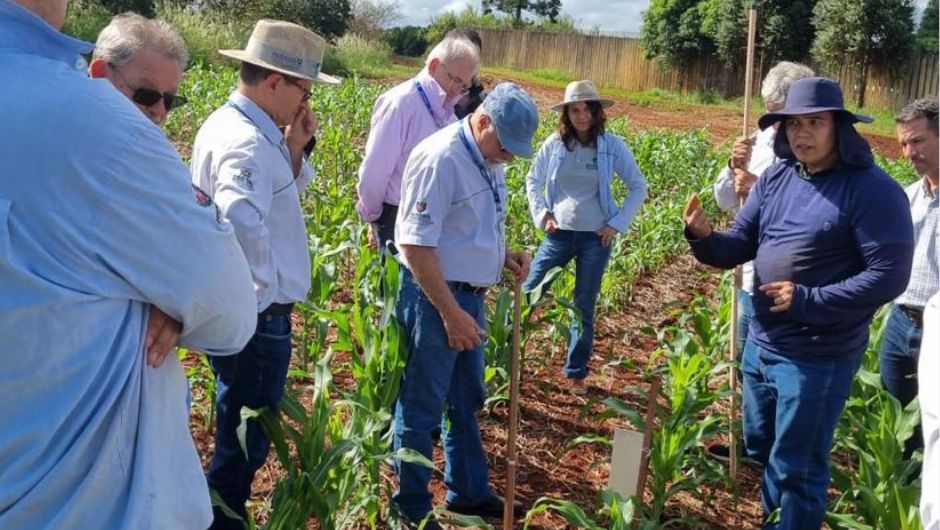May: what will the weather be like in Brazil?
The forecast indicates above-average rain in much of the North and South regions

Representatives of entities dedicated to agricultural research met at the Institute of Rural Development of Paraná-Iapar-Emater (IDR-Paraná), in Londrina, for training and the beginning of the project to monitor the population fluctuation of the corn leafhopper in current harvest. The work is carried out by the Agricultural Research Network Corn Stunting Complex in Paraná, of which IDR-PR is part.
Created in 2023 to meet the growing demands of the state's agricultural sector, the network has stood out in tackling the damage caused by stunting and viruses transmitted by the corn leafhopper (dalbulus maidis). Given the complexity of this challenge, it was structured into three priority axes: monitoring, cultivar reactions and chemical and biological control.
The training given last week by the team of researchers from the Plant Protection Area covered everything from the installation and collection of sticky traps to the taxonomy and identification of the dalbulus maidis, as well as updates on the insect’s bioecology. 12 extensionists from IDR-Paraná participated, representing six mesoregions that produce second harvest corn.
The technical protocol resulting from this meeting, which will serve as a basis for monitoring in reference units, will also be studied in new training courses covering other producing regions.
“IDR-Paraná stands out in generating this information network thanks to the capillarity of technicians in the municipalities, and with data on the insect's biology we can adjust management strategies”, highlighted Ivan Bordin, researcher in the area of Phytotechnics. The team also included researchers Rodolfo Bianco, Humberto Godoy Androcioli, Adriano Thibes Hoshino and Michele Regina Lopes da Silva.
In addition to monitoring, the technical team highlighted the importance of strategies such as selection of genetically tolerant cultivars, seed treatment, regular spraying, weed control, planting planning and environmental control to mitigate the impacts of pests. The initiative aims to generate population distribution maps of the corn leafhopper and issue alerts during critical periods of the crop. The information is essential to guide technicians and producers in adopting best agricultural practices.
“These alerts allow producers to know how the leafhopper populations are in their region and also their effectiveness with pathogens. So that you can decide whether or not to intensify management actions against corn stunting complex diseases,” said Michele.
Disease – the disease involves the insect dalbulus maidis, which transmits the streak virus and the bacteria phytoplasma and spiroplasma, also known as molicutes. For this reason, technicians call it the stunting complex.
The leafhopper becomes infected by sucking the sap from infected plants and transmits the pathogens when it feeds again on healthy crops. It can fly within a radius of 30 kilometers, but is transported by air currents that reach greater distances.
Plant infection occurs in the period from emergence to approximately 35 days, although the symptoms — red or yellow spots on the edges of the leaves or in the shape of stripes and little plant development — appear when the crop is already in the bolting phase. and grain formation.
The stunt complex was first detected in western Paraná around 20 years ago, in sporadic and localized occurrences. From 2017 onwards, reports of its presence in crops increased.
The main recommendations for dealing with the disease are the use of tolerant cultivars and constant inspections in the period from plant emergence to the eight-leaf stage, with the aim of evaluating the presence of the leafhopper and the need for its control with chemical insecticides. or biological.
It is also recommended to use treated seeds and simultaneous sowing in the same region to avoid the so-called “green bridge”, which is the existence of crops at different stages of development.
Eliminating tigueras, or raccoon plants, from the land is important to interrupt the leafhopper and pathogen cycle.
In addition to IDR-Paraná, the Agricultural Defense Agency of Paraná (Adapar), the State University of Londrina (UEL), the State University of Northern Paraná (Uenp), the University Ponta Grossa State University (UEPG), the Central-West State University (Unicentro), the Federal Technological University of Paraná (UTFPR), UniCesumar, Embrapa Milho e Sorgo, Embrapa Cerrados, in addition to the cooperatives Coamo, Cocamar, Copacol and Integrated.
The planned investment in the network is R$ 3,8 million, resources coming from the Araucária Foundation, an entity that supports scientific and technological development linked to the State Secretariat for Science, Technology and Higher Education of Paraná, and the National Rural Learning Service (Senar-PR). The duration of the projects is three years.
“The work we have been doing since last year has proven successful. With the engagement of the network's partners and funders, we were able to establish integration strategies and we will increasingly disseminate research results to the academic community and producers, in order to overcome the challenges of this disease”, stated the research director and innovation from IDR-Paraná, Vânia Moda Cirino.

Receive the latest agriculture news by email
The forecast indicates above-average rain in much of the North and South regions
The event took place from April 5th to 14th and brought together more than five thousand animals, as well as the main national manufacturers of agricultural machinery and vehicle dealerships.